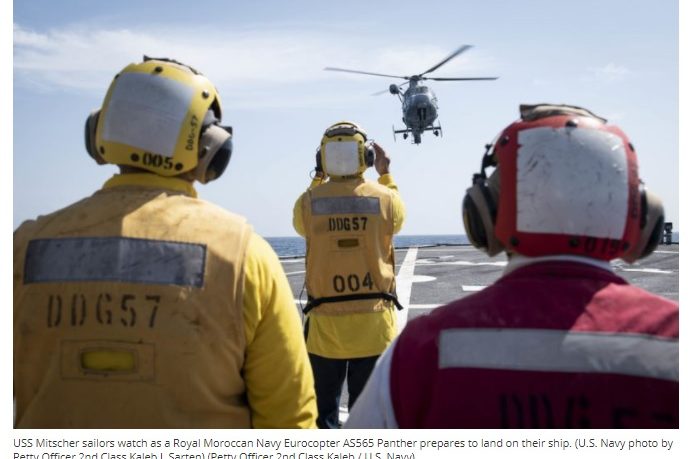By DAVE RESS DAILY PRESS
For helicopter pilots, approaching a Navy destroyer flight deck is like aiming for a postage stamp, says Capt. Scott Jones, commodore of the Norfolk-based destroyer squadron deployed with the USS Dwight D. Eisenhower strike group. It takes lots of practice for pilots and the sailors down below, he said.
And that’s what pilots from the Royal Moroccan Navy got during the strike group’s three-day joint operations exercise with one of America’s oldest allies — 244 years and counting.
“The goal is to build trust. There’s only so much you can do with phone calls or power points. You have to operate together to build trust,” said strike group commander, Rear Adm. Scott Robertson.
The exercise, called Lightning Handshake, marked the first time Robertson, Jones and the air wing commander, Capt. Marcos Jasso, operated with the Moroccan navy and air force, though the strike group included sailors from the USS Harry S. Truman strike group that conducted a similar exercise in 2018.
The ships drilled with a Moroccan frigate, maneuvering close to one another while firing live rounds, as they practiced operations against submarines and other surface ships.
Different ships — the Moroccan frigate is a Dutch design — have different capabilities, and there’s nothing like working together to get a feel for that, Jones said.
The air wing coordinated with Moroccan pilots on live-fire exercises onshore, operations that included American personnel on shore working with their Moroccan counterparts as on-the-ground operation controllers.
“It’s a chance to tap regional expertise,” said Jasso.
The Moroccans shared critical knowledge about the challenges a desert environment can pose, as well as the cultural and historic sensitivities which, if ignored, can limit a naval air strike’s war-winning objectives, he said.
For the Moroccans, the exercise also offered a change to practice in-flight refueling from a fighter jet — something the Navy has done for decades but that they don’t get a chance to do that often, he said.
The Moroccan Navy helicopters aiming for that postage-stamp sized flight deck on USS Mitscher were drilling on the key step in getting badly needed parts or supplies to a ship or equipment and key personnel — like those on-the-ground controllers — to the shore. Helicopters on destroyer, cruiser or Coast Guard cutter flight decks evacuate sick and injured sailors and operate search-and-rescue missions, too.
“What we do is inherently dangerous,” Jones, the destroyer commodore, said. “So when we get a chance to practice with our allies, it’s an opportunity to build trust and confidence in what we do.”
The full range of surface warfare, anti-submarine, on-shore strike and logistical support operations that the strike group and the Moroccans practiced are particularly important since Morocco guards approaches to the Straits of Gibraltar, a possible chokepoint on the sea route between the United States and the countries of the Mediterranean Sea.
“We’ve been allies for 200 years, and this is a way of saying we’ll be there for the next 200,” said Jones.
The strike group had another chance, right after the exercise with the Moroccan navy and air force ended — the Italian frigate ITS Luigi Rizzo was nearby and the strike group sailed in formation with it for a time.
“That was completely impromptu,” Robertson said. “But we’re always looking for a chance to operate with our allies.”
Dave Ress, 757-247-4535, dress@dailypress.comDave RessStaff WriterCONTACT
Dave Ress covers the military. He’s been a reporter in Virginia since 1990 and before that for Reuters in Canada, Britain and Africa. Dave has a PhD in history from the University of New England (Australia) and is the author of 4 books on U.S. and Australian history.







